In March 2023, I flew back to Sichuan after more than three years away from home. Everything tasted even better than I’d imagined—even the food in a museum. One of the memorable meals was a buffet at the Museum of Sichuan Cuisine (yes, this museum includes a lunch buffet as part of the entrance). I was mesmerized by my first bite of Zhong Dumplings served in a humble paper cup—and equally captivated watching the aunties effortlessly wrapping and cooking them while casually chatting with each other.
Growing up, I wasn’t the biggest fan of boiled dumplings (shuijiao 水饺). I often preferred boiled wontons (called chaoshou 抄手 in Sichuan) for their delicate, thin skins. In my younger eyes, there was a clear distinction between the two. Yet Zhong Dumplings were the one exception—snack-sized bites served in a sweet and spicy sauce made with Sichuan chili oil and aromatic sweet soy sauce (fuzhi jiangyou 复制酱油), the same irresistible sauce used for sweet water noodles (this is one of my most-clicked recipes).
Zhong Dumplings (Zhong Shuijiao, 钟水饺) are one of Chengdu’s three most famous street foods—alongside Long Chaoshou (soup wontons) and Lai Tangyuan (sweet sticky rice balls), a trinity that often found in touristy spots. I remember visiting one of these iconic chain restaurants with my family as a teenager. After a long day of shopping at the busy Chunxi Lu, we’d stop by the canteen-like hall, where rows of small eats (xiaochi)—noodles, dumplings, and sweet dim sum—awaited us. You’d pay at the counter, then pick up your selections from different windows.
It’s been at least 15 years since I last visited one of those spots. For years, I actively avoided “touristy” places like these. But after living abroad for almost a decade, I’ve started to embrace my inner tourist when I return home. On the other hand, my relationship with dumplings has changed profoundly. They’ve become a staple of my Chinese New Year celebrations with my diaspora friends in Germany (and honestly, an all-year-round comfort food).
This recipe is adapted from a vintage cookbook I stumbled upon in a secondhand bookshop near Yulin Market in Chengdu: Chinese Snacks: Sichuan Cuisine (中国小吃: 四川风味). This 80s cookbook is written in traditional Chinese measurements (the market system, or shizhi 市制). After translating them into grams and approximate teaspoon, the recipe itself worked surprisingly well with only a few minor tweaks.
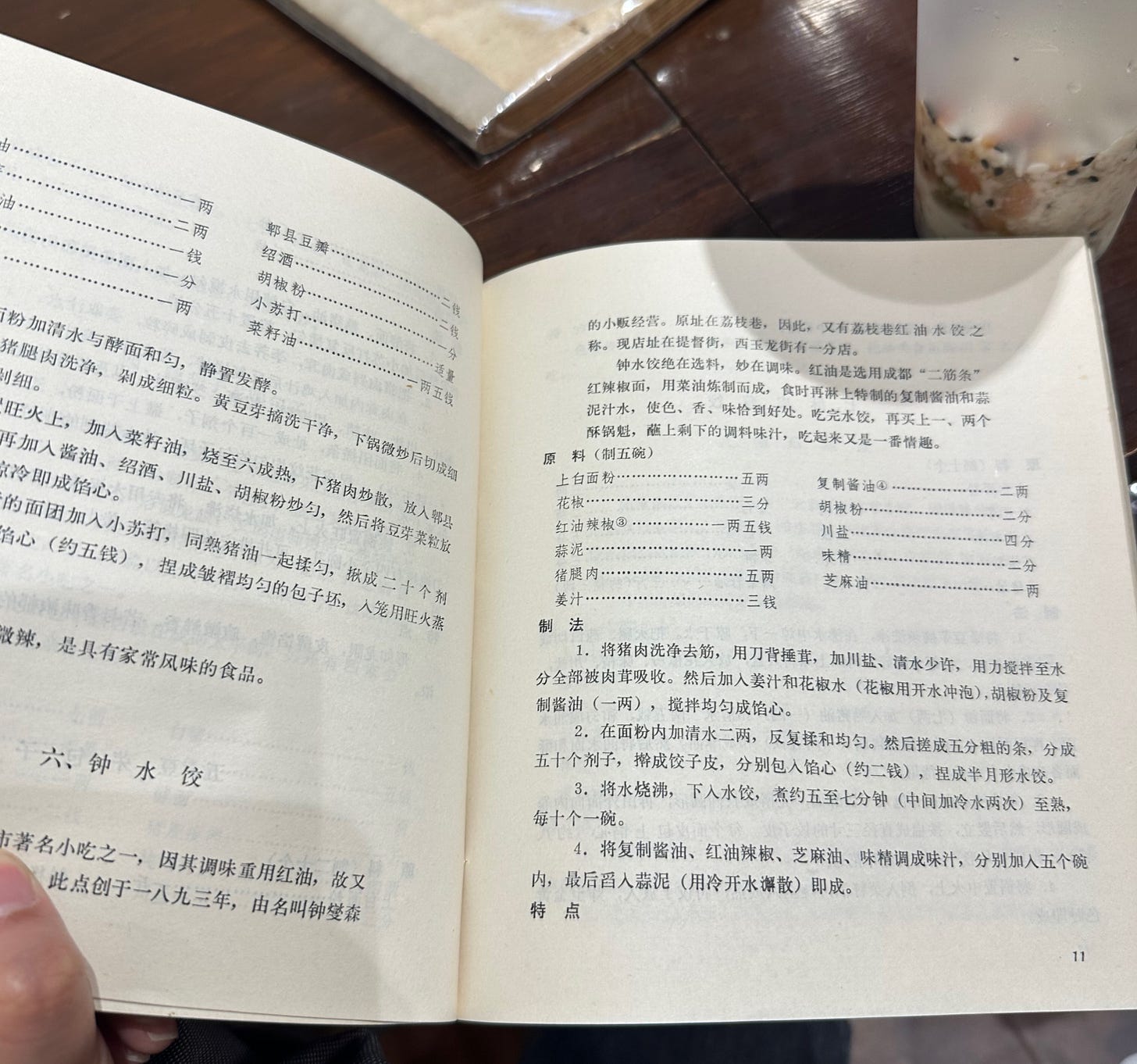
Recipe for Zhong Dumplings
Makes about 25–30 dumplings
For the dough:
250g (2 cups) all-purpose flour
120–125g (1/2 cup) room-temperature water
1/4 tsp salt
For the filling:
250g (9 oz.) ground pork
1/2 tsp salt
1/8 tsp white pepper
2 tbsp Sichuan pepper water
2 tbsp ginger water
2 tbsp aromatic sweet soy sauce (recipe below)
1/4 tsp Sichuan pepper oil (optional)
For the bowl sauce (per serving):
1–2 tsp Sichuan chili oil
1–2 tbsp aromatic sweet soy sauce
1 tsp sesame oil
1 clove crushed or grated garlic mixed with 1 tsp water
A pinch of MSG (optional)
Instructions:
Make the dough: In a mixing bowl, combine the flour and salt. Gradually add the water, mixing with chopsticks until small dough pieces form. Bring the dough together with your hands and knead for 1–2 minutes until smooth. Cover with plastic wrap or a kitchen towel and let rest for 30 minutes while you prepare the filling.
Make the filling: Brew 1/2 tsp Sichuan pepper in 2 tbsp hot water and let it steep for 5 minutes. Grate ginger into a small bowl, add 2 tbsp room-temperature water, and strain. In a mixing bowl, combine the ground pork, salt, and white pepper. Gradually add the Sichuan pepper water and ginger water, stirring with chopsticks until the meat absorbs all the liquid and turns into a sticky paste. Add aromatic sweet soy sauce and Sichuan pepper oil (if using), and mix until fully incorporated.
Form the wrappers: Lightly flour your work surface. Divide the dough into four equal pieces, roll each into a long log, and cut into approx. 12g (0.4 oz) portions. Flatten each piece with your palm, then roll it into a thin circle about 8 cm (3 inches) in diameter with a rolling pin.
Wrap the dumplings: Place 1 tsp of filling in the center of a wrapper. Fold it into a half-moon shape, pressing the edges to seal. No pleats are needed for this recipe.
Cook the dumplings: Bring a large pot of water to a boil. Add the dumplings, and use a ladle to swirl the water gently to prevent sticking. Cook over medium-high heat for 5–7 minutes, adding a splash of cold water twice when the pot comes to a boil. Ladle the dumplings into serving bowls and top with the bowl sauce.
Tips for Perfect Zhong Dumplings
Making the aromatic sweet soy sauce
I used the same recipe from sweet water noodles, but omit the Sichuan pepper.
Prepare 1 star anise, 1 Chinese cinnamon stick, 1 bay leaf, 1/2 tsp fennel seeds, 1 tsaoko, 1 dried shittake mushroom and 3 ginger slices, add them to 100ml simmering water, cook for about 5 min.
Add 250g (1 cup) soy sauce and 150g (3/4 cup) dark brown sugar to the pan, bring to a boil, and let it simmer over low heat for at least 30 minutes until the soy sauce thickens and becomes syrupy, reducing by 1/3 or half. Strain out the spices, let cool, store the sauce in a bottle for up to 3 months (or longer).
Dumpling Dough
This dough is a standard soft dumpling and noodle dough I used for all recipes, with a 50% hydration rate. In Sichuan cooking, this type of soft, unleavened dough is called ruanzi mian (软子面). Some recipes ask for an egg as part of the liquid, but I tested both, and it has no significant difference. It doesn’t require heavy kneading—just 30 minutes of resting, which allows the gluten to relax. This makes the dough easier to roll and less likely to shrink or tear. After the resting he dough should look and feel smooth. You can also use store-bought dough wrappers but they would be less chewy.
Dumpling Filling
Unlike most northern-style dumpling fillings, which often mix vegetables and meat, Zhong Dumplings are made with pure pork. That said, you can use vegetarian option (with eggs), or a plant-based substitute like Beyond Meat could work for a vegan option.
One technique from the old recipe is to infuse the aromatics (like Sichuan pepper and ginger) in water, rather than adding them directly. This creates a more subtle, balanced flavor. Brewing Sichuan pepper in hot water extracts its fragrance without making the filling overly numbing. Combined with the aromatic sweet soy sauce, this process ensures the pork stays juicy, tender, and slightly bouncy once cooked.
Click for my other dumpling recipes featuring spring ramps, winter kale and how to pan-fry dumplings with a crispy-skirt.
Ramp Dumplings to Celebrate Spring
In Germany, every day still feels like an arbitrary toss-up between spring and winter, but hope is on the horizon: early cherry trees begin to blossom under the gentle rays of sunshine, while tulips and asparagus slowly debut on the market. My Chinese calendar reminds me that it’s Chun Fen (春分, spring equinox day) this week around March equinox day, a

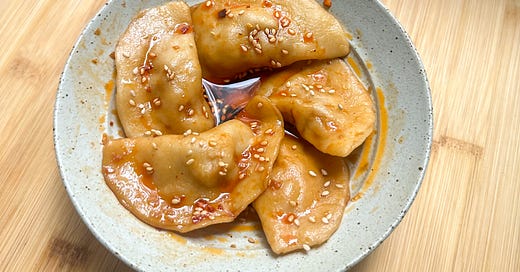



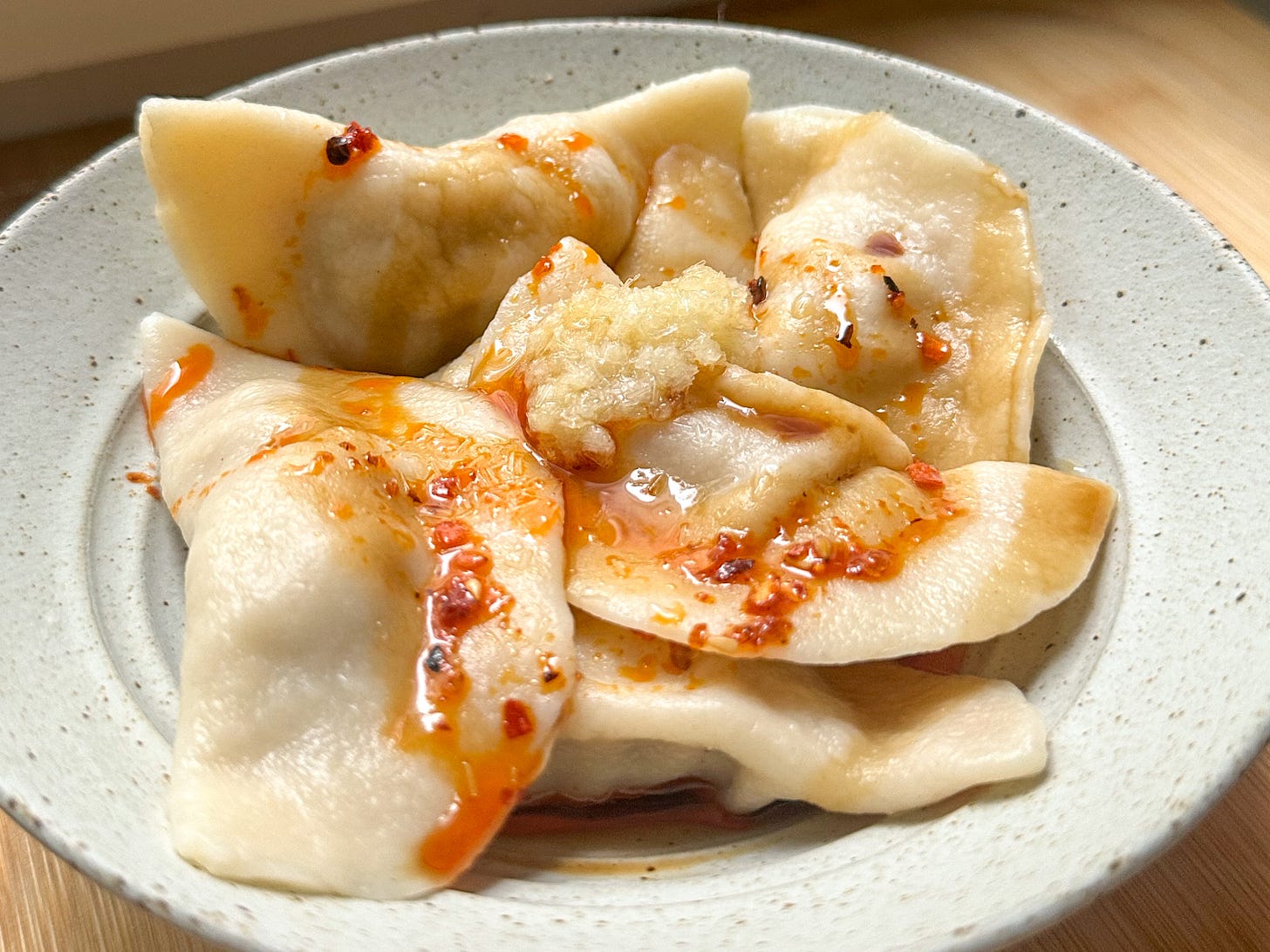
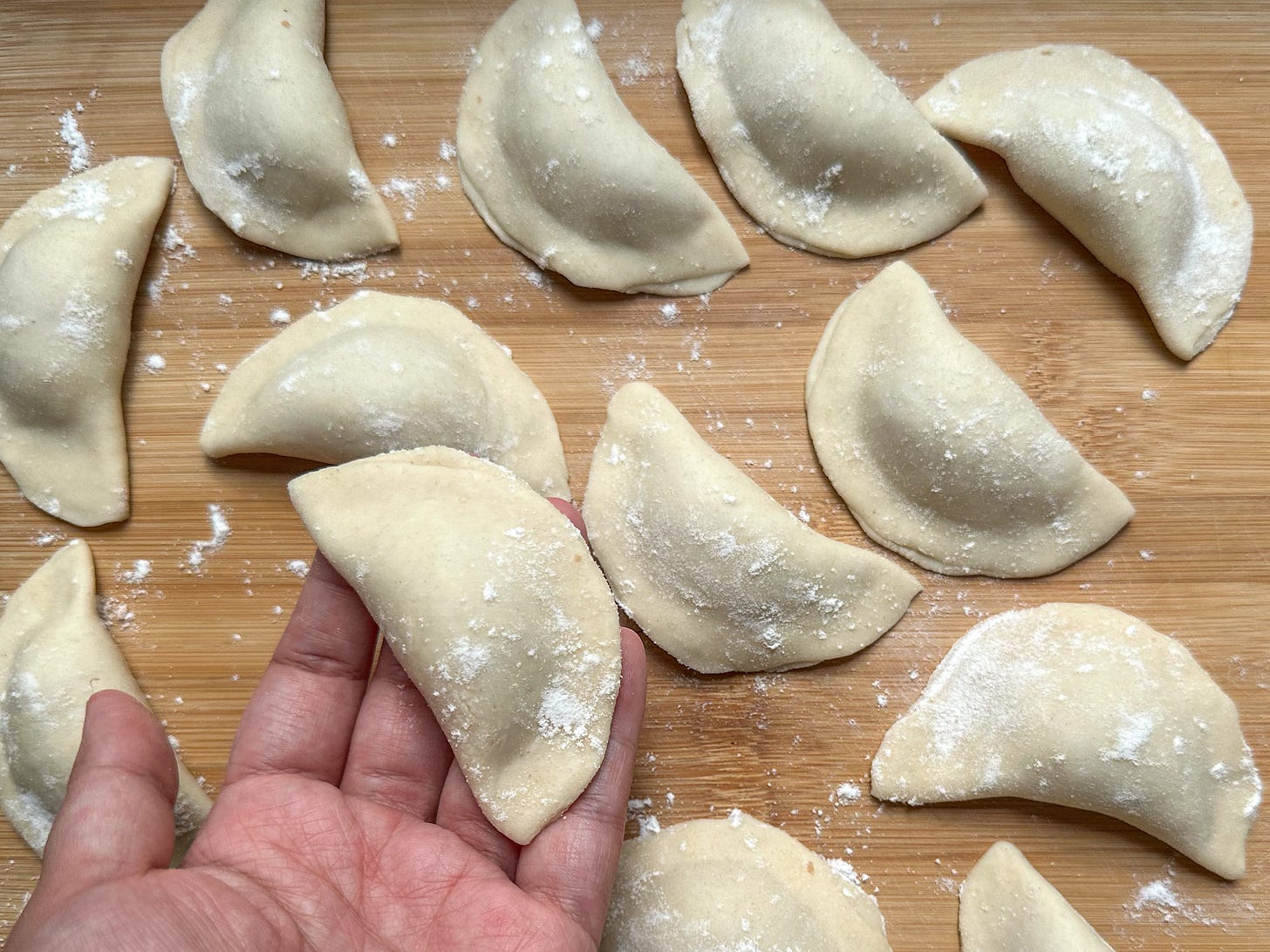
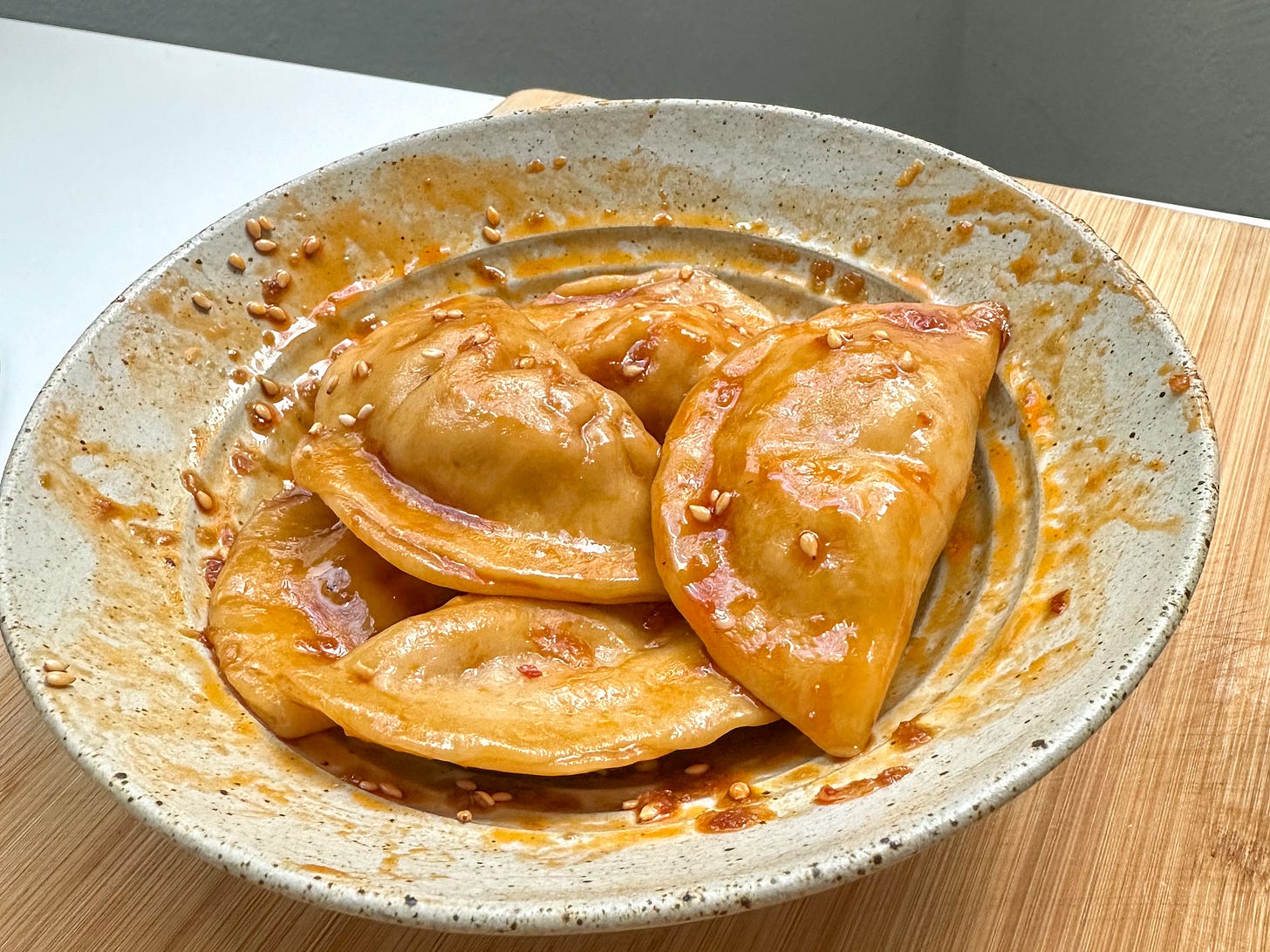

Can’t wait to try these!